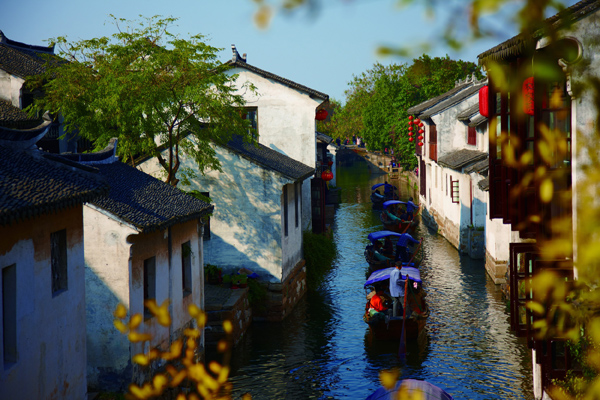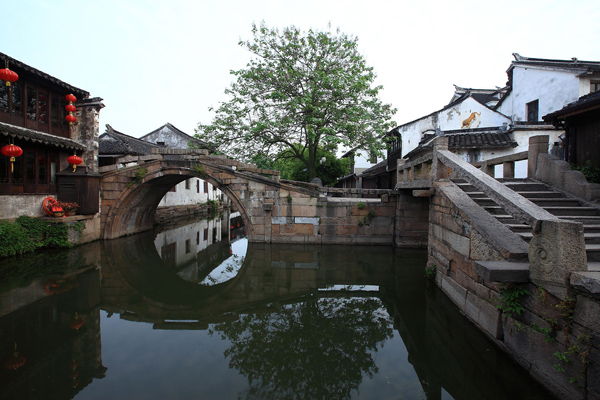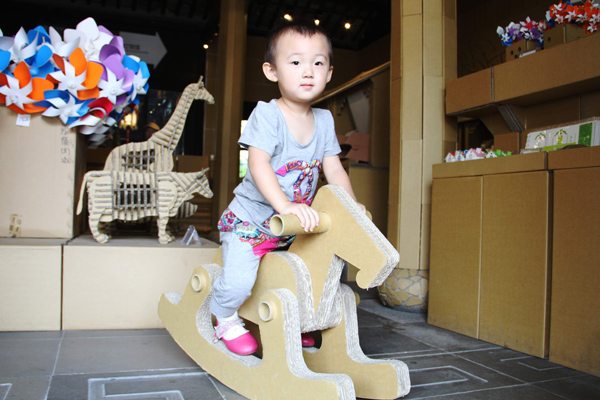
The ancient town of Zhouzhuang celebrates a storied past and an environment-friendly future, all in a setting that's straight out of a Chinese watercolor.
Zhouzhuang is one of the few places where you can experience the life of a typical Chinese water town.
Acclaimed as "Venice of the East", the town near Suzhou in Jiangsu province attracts a constant flow of visitors throughout the year with its well-preserved old houses and picturesque landscape of crisscrossing waterways.
 |
|
Waterways flow through every corner of Zhouzhuang, flanked by well-preserved old houses with white walls and black-tiled roofs.Photos provided to China Daily |
Zhouzhuang was listed as the world's Top 10 most beautiful towns by CNN in 2012. It was lauded as a Global Green Town by Global Forum on Human and Settlements in June.
Streams flow through every corner of Zhouzhuang, creating the pulse of local life and making the town look like a watercolor drawing painted with a Chinese brush.
Among the most eye-catching features in this picture-perfect landscape are the bridges, in different shapes and sizes — built with stone or wood.
 |
|
Twin Bridge, built during the Ming Dynasty (1368-1644), is a must-see in Zhouzhuang. |
The Twin Bridge, built during the late Ming Dynasty (1368-1644), is considered the symbol of the town. One of its arches is round and the other is rectangular, which makes the bridge look like an ancient Chinese key. Thus locals also call it the Key Bridge.
The traditional residences in town, mostly built in the Ming and Qing dynasties (1644-1911), flank the winding waterways. Many of them are well-kept and preserve their original appearance, with white walls and black-tiled roofs.
The best way to get a taste of local lifestyle is spend an afternoon at a riverbank teahouse, sipping a cup of green tea and enjoying the river landscape.
In addition to the town's old charm, Zhouzhuang is striving to create new draws and improve its tourism facilities, according to Ren Yongdong, managing director of Zhouzhuang Tourism Company.
Carton King Creativity Park is one of the new attractions on Zhouzhuang's tourist map.
The park, including stores, a gallery, a museum and a restaurant, has become a must-see since its opening in August last year.
Everything you see in the park is made of cardboard cartons, from figurines and animals to hats, bags and furniture.
"They are not just for display," explains Chen Weilin, general manager of the Carton King Creativity Park. "A chair made of cartons can support as much weight as 200 kg."
 |
|
Everything in Carton King Creativity Park is made of cardboard cartons, from toys to furniture, which are particularly attractive to young visitors. |
The park is the Taiwan company's first store on the Chinese mainland, Chen says. "All the materials are recycled corrugated paper to make furniture and crafts, which are environment-friendly and creative," Chen says.
Chen is optimistic about the future of the park. "With the rapid development of Chinese economy, tourists' purchasing power will increase, and there will be great development space in Zhouzhuang."
The 1086 Street is another new site to showcase local cultural heritage. The 200-meter-long street is a concentration area of lodging and catering. More recreational facilities like bars and coffee shops have been planned for construction in the near future, according to Ren.
Some of the businesses are run by people from other parts of the country.
Bar owner Guo Tao, from Lijiang in Yunnan province, is one of them.
Guo and his wife first visited Zhouzhuang in 2010. "We fell in love with the town during our one-week stay. Then we decided to move here."
Business was not very good two years ago but it's getting better, with more returning customers, Guo says.
"In Zhouzhuang, I can find the freedom of the soul. I hope one day I could buy a house of my own and finally settle down."
On Minsu Street there are dozens of inns run by local residents. The decorations are authentic and the inn-owners are considerate, honest and enthusiastic.
Zhu Sanguan, 72, once an actor, works at a hotel in town.
A few years ago, Zhouzhuang was very quiet with few tourists and people lived a leisurely life, Zhu recalls. "Most of us lived on farming and fishing."
With the town's increasing popularity, the number of tourists skyrocketed. Many people in the town opened hotels and restaurants, and sold souvenirs.
"Life is much better and busier," Zhu says.
"People used to go to bed after the sunset," he says. "Days like that are long gone."
Li Yingqing and Hu Yongqi contributed to the story.
